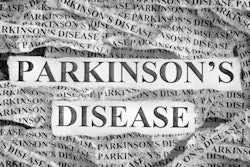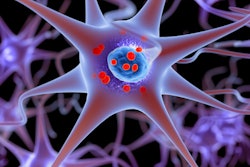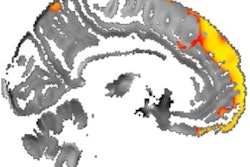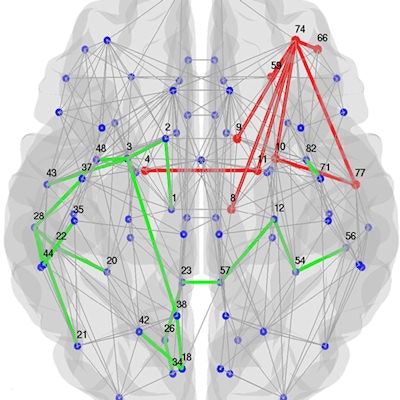
Using an MRI technique known as diffusion-tensor tractography and graph analysis, European researchers have discovered structural disruptions in certain brain networks of people with Parkinson's disease and cognitive impairment, according to a study published online December 7 in Radiology.
The findings suggest MRI could provide markers such as decreased fractional anisotropy that, in turn, would be used to monitor Parkinson's disease and help predict additional cognitive complications.
"The main finding of our study was that Parkinson's with mild cognitive impairment is associated with a structural network disruption involving basal ganglia and the frontotemporoparietal region," wrote lead investigator Dr. Massimo Filippi, from San Raffaele Scientific Institute in Milan, and colleagues. "These results suggest that cognitive impairment in patients with Parkinson's is likely the consequence of a disruption of complex structural brain networks rather than degeneration of individual white-matter bundles."
Parkinson's complications
Parkinson's disease leads to a decline in both motor function and cognitive function and can be complicated by mild cognitive impairment in 25% of newly diagnosed Parkinson's patients. Those people with mild cognitive impairment, of course, often progress to dementia.
Filippi and colleagues noted that only a handful of studies have investigated how Parkinson's and mild cognitive impairment affect the pattern and connections of microstructures in the brain's white matter. Available research suggests that cognitive deficits are associated with abnormalities of frontal and interhemispheric white-matter connections.
"More importantly, several studies showed that white-matter abnormalities, as revealed by diffusion-tensor MRI, may precede gray-matter atrophy in patients with Parkinson's but without dementia," they wrote (Radiology, December 7, 2016).
The researchers evaluated 54 patients (32%) with Parkinson's and mild cognitive impairment and 116 patients (68%) with Parkinson's and no evidence of cognitive impairment. They matched a subgroup of 54 patients with Parkinson's but no mild cognitive impairment with the patients with Parkinson's and mild cognitive impairment according to demographics. The study also included a group of 41 healthy control subjects.
Participants underwent MRI scans on a 1.5-tesla system (Achieva, Philips Healthcare) with protocols of dual-echo fast spin-echo, 3D T1-weighted transient field echo, pulsed gradient spin-echo single-shot echo-planar, and diffusion-tensor sequences.
Diffusion-tensor imaging measures the movement and diffusion of water molecules in the brain and is an indicator of the condition of the brain's signal-carrying white matter. A low fractional anisotropy value from DTI would mean a disruption in water molecule flow and that signal-carrying capability.
Diffusion-tensor tractography was then used to create a detailed map, or connectome, of both structural and functional brain components in the subjects. A graph analysis was applied to the DTI results to measure the relationships and deficiencies with the complex network of connections in the human brain.
Structural changes
The analyses revealed that patients with Parkinson's and mild cognitive impairment had a large basal ganglia and frontoparietal network with decreased fractional anisotropy in the right hemisphere and a subnetwork with increased mean diffusivity, compared with control subjects (p ≤ 0.01).
Those with Parkinson's and mild cognitive impairment also showed decreased fractional anisotropy, including basal ganglia and frontotemporoparietal regions, compared with patients with Parkinson's and no mild cognitive impairment (p < 0.05).
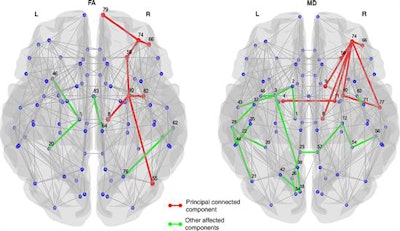 The images show affected structural connections in patients with Parkinson's disease and mild cognitive impairment relative to healthy control subjects and patients with Parkinson disease with no mild cognitive impairment. The principal connected component is shown in red, and other affected connections not included in the principal connected component are shown in green. Subnetworks show altered structural connectivity with decreased fractional anisotropy or increased mean diffusivity in patients with Parkinson's and mild cognitive impairment relative to healthy control subjects. Images courtesy of Radiology.
The images show affected structural connections in patients with Parkinson's disease and mild cognitive impairment relative to healthy control subjects and patients with Parkinson disease with no mild cognitive impairment. The principal connected component is shown in red, and other affected connections not included in the principal connected component are shown in green. Subnetworks show altered structural connectivity with decreased fractional anisotropy or increased mean diffusivity in patients with Parkinson's and mild cognitive impairment relative to healthy control subjects. Images courtesy of Radiology.There were no regional network changes seen in the comparison of subjects with Parkinson's and no mild cognitive impairment and healthy control subjects (p < 0.01).
"These results suggest that cognitive impairment in patients with Parkinson's is likely the consequence of a disruption of complex structural brain networks rather than degeneration of individual white-matter bundles," the group concluded.
The researchers cited several limitations of the study, including the presence of crossing fibers, which can cause uncertainty in the estimation of the model. "Thus, potential errors in tract reconstruction with diffusion-tensor tractography may have occurred in regions where such fiber disposition is more frequent," they noted.
As for future research, Filippi and colleagues obtained resting-state functional MRI data from the patients and plan to study functional connectome alterations associated with cognitive impairment in Parkinson's and how structural and functional abnormalities are interrelated.






